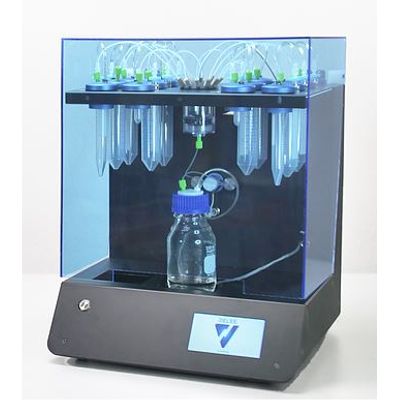

- Home
- Companies
- DELEE Corp
- Products
- Model CytoCatch technology - Taking ...

Model CytoCatch technology - Taking Liquid Biopsies from the Laboratory to Clinical Practice
CytoCatch™ is a patent pending technology that consists of an isolation platform and an imaging system created to effectively isolate and analyze CTCs from blood samples.
Possesses special routines and machine learning algorithms that analyze the captured cells based on their morphology and the expression of specific markers.
The fact that all these processes are fully automated increases the reliability and reproducibility of the assay by preventing human errors and cell loss due to manual steps. Furthermore, the collected cells are compatible with traditional molecular biology techniques and next generation sequencing technologies, making it possible to perform molecular analyses to assess the genetic characteristics of the captured CTCs.
No labels required
While many of the technologies developed to isolate CTCs from blood are based on sample enrichment methods that depend on specific antigen-antibody interactions, the principle of separation of the CytoCatch™ isolation platform is based on the differences in size and deformability between blood cells and CTCs, enabling the capture of CTCs without requiring any labels.
Outstanding recovery rates
Due to their inherent rareness and to avoid losing valuable information, it is fundamental that the platform captures the vast majority of the CTCs present in the sample. The CytoCatch™ technology has recovery rates above 93% when processing 7.5 mL blood samples spiked with tumor cells from prostate, breast, and colorectal cancer cell lines, meaning that the platform recovers at least 93 out of 100 tumor cells spiked into the sample.
Personalized medicine
The CytoCatch™ technology consists of a fully automated isolation platform and an imaging system that efficiently isolates and analyzes CTCs from blood samples, without human intervention
High-speed sample processing
The CytoCatch™ isolation platform can process 7.5 mL blood samples in less than 12 minutes, in comparison with other technologies that can only process significantly lower sample amounts and/or require hours to do so.
Recovery of viable CTCs
Viable CTCs can be recovered from the platform’s microfiltration membrane, demonstrating that the shear stress exerted on cells during sample processing did not compromise their integrity.
Cell inmunostaining
Perform cell phenotypic analysis and identify diagnostic, predictive, prognostic, and/or therapeutic markers expressed in CTCs, such as AR-V7, HER-2, EGFR, and PD-L1.
Cell culture
Viable CTCs can be isolated from the sample for culture, enabling in vitro assessment of drug susceptibility/ resistance on the captured cells.
Cell sequencing
Detect mutations that could confer therapeutic susceptibility / resistance to targeted therapies. The isolated cells are compatible with traditional and next generation sequencing (NGS) technologies.
Gene expression analysis
Detect and quantify mRNA levels of specific genes using techniques, such as qRT-PCR, digital PCR, and RNA-Seq. scent probes to perform gene expression analysis using techniques, such as DNA microarrays, RT-PCR, qRT-PCR, and digital PCR.
Most of the technologies developed to isolate CTCs from blood are based on sample enrichment methods that depend on specific antigen-antibody interactions, such as microfluidic devices functionalized with biomolecules that act as targeting ligands or platforms that use micro- or nano-magnetic particles coated with specific antibodies as a mean to isolate these rare cells. Although these technologies have demonstrated clinical utility, a fundamental problem of these approaches is the lack of a universal surface marker that is consistently expressed by CTCs. Most of these technologies, including the CellSearch System, which is considered the current gold standard, use EpCAM (epithelial cell adhesion molecule) antibodies to selectively trap cancer cells to the functionalized substrate/particles. However, CTCs intravasate into the bloodstream by undergoing a process known as the epithelial-mesenchymal transition (EMT), in which their epithelial phenotype is downregulated, including the expression of EpCAM antigens. This fact limits the capture of CTC subpopulations with diminished expression of this specific surface marker, thereby losing valuable information. The sample enrichment method used by the CytoCatch™ isolation platform is based on the differences in size and deformability between blood cells and CTCs, this enables the isolation of CTCs irrespective of the expressed levels of antigens in their membranes, allowing the capture of cells that would otherwise be impossible with different technologies.
